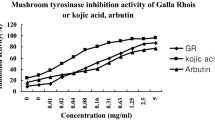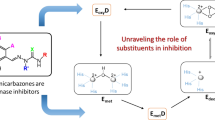Abstract
The oxidation-reduction potentials of cosmetic raw materials, showing tyrosinase inhibitory action, and phenolic compounds structurally similar to L-tyrosine were determined by cyclic voltammetry. The voltammograms obtained could be classified into 4 patterns (patterns 1–4). Pattern 1, characterized by oxidation and reduction peaks as a pair, was observed with catechol, hydroquinone or phenol, and pattern 2 exhibiting another oxidation peak in addition to oxidation and reduction peaks as a pair was found with arbutin, kojic acid, resorcinol, methyl p-hydroxybenzoate and L-tyrosine as the substrate of tyrosinase. Pattern 3 with an independent oxidation peak only was expressed by L-ascorbic acid, and pattern 4 with a reduction peak only at high potentials, by hinokitiol. The tyrosinase inhibitory activity of these compounds was also evaluated using the 50% inhibitory concentration (IC50) and the inhibition constant (Ki) as parameters. Hinokitiol, classified as pattern 4, showed the highest inhibitory activity (lowest IC50 and Ki). Hydroquinone showing the second highest activity belonged to pattern 1, which also included compounds showing no inhibition of tyrosinase activity. The inhibitory activity of compounds exhibiting pattern 2 was relatively low with Ki values being in the order of 10−4 M. Although there was no consistent relationship between oxidation-reduction potentials and tyrosinase inhibitory action, the voltammetry data can be used as an additional index to establish the relationship between the structure and the tyrosine inhibitory activity.
Similar content being viewed by others
References Cited
Japan Cosmetic Ingredients Dictionary (4th ed.),Jpn. Cos. Ind. Assoc., Yakuji-Nippo Co., Tokyo, 1997.
Lowry, O.H., Rosenbrough, N.J., Farr, A.L. and Randall, R.J., Protein measurement with the folin phenol reagent,J. Biol. Chem., 193, 265–275 (1951).
Maeda, K. and Fukuda, M., Arbutin: Mechanism of its depigmenting action in human melanocyte culture.J. Phamacol. Exp. Ther., 276, 765–769 (1996).
Morioka, T. and Yamaguchi, Z., An Outline of Modern Dermatology (15th);,Hyperpigmentation, Chloasma, Nakayama-shoten, Tokyo, pp. 104–107, 1983.
Pomerantz, S.H. and Li, J. P.-H.,Methods Enzymol., Vol. 37 (Tabor, H. and Tabor, C.W. ed), Academic Press, New York, pp. 620–626, 1970.
Prota, G., Ortonne, J., Voulot, C., Khatchadourian, C., Nardi, G. and Palumbo, A.,Comp. Biochem. Physiol., 68b, 415 (1981).
Sharma, L.R. and Sharma, A., Redox behaviour of hydroquinone in aqueous and non-aqueous solutions,Indian J. Chem., 26A, 659–661 (1987).
Takamura, K., Inoue, S., Ito, K. and Kusu, F., Voltammetric determination of phenothiazine drugs using anodically oxidized carbon electrode,Bunseki Kagaku, 35, 161–165 (1986).
Takano, M.,Dermatosis and External Use Products, Nanzando, Tokyo, 1984.
Author information
Authors and Affiliations
Corresponding author
Rights and permissions
About this article
Cite this article
Sakuma, K., Ogawa, M., Sugibayashi, K. et al. Relationship between tyrosinase inhibitory action and oxidation-reduction potential of cosmetic whitening ingredients and phenol derivatives. Arch Pharm Res 22, 335–339 (1999). https://doi.org/10.1007/BF02979054
Received:
Issue Date:
DOI: https://doi.org/10.1007/BF02979054




